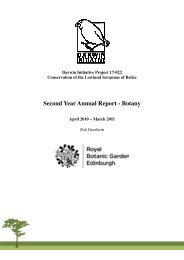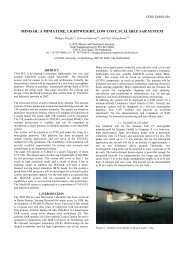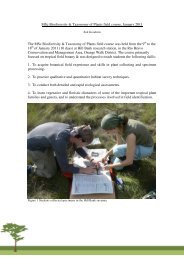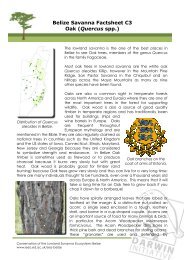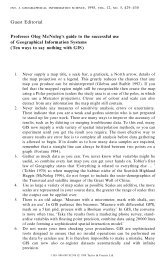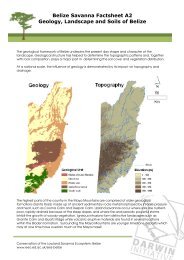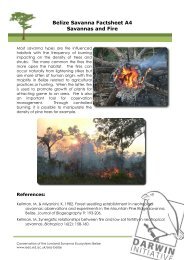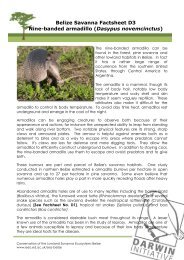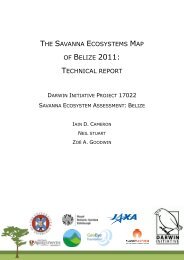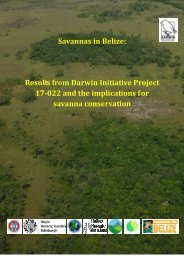Belize Savanna Factsheet C8 Parasitism - Research
Belize Savanna Factsheet C8 Parasitism - Research
Belize Savanna Factsheet C8 Parasitism - Research
You also want an ePaper? Increase the reach of your titles
YUMPU automatically turns print PDFs into web optimized ePapers that Google loves.
<strong>Belize</strong> <strong>Savanna</strong> <strong>Factsheet</strong> <strong>C8</strong><strong>Parasitism</strong><strong>Parasitism</strong> is a popular strategy for savanna plants. A whole range of plants areeither holoparasitic (totally reliant on other species for water or nutrients) orhemiparasitic (partially reliant on other species and may be facultative or obligatehemiparasites). The vegetative parts of holoparasites tend to be white or a palecolour, normally with now redundant leaves reduced to scales or absent almostentirely. Hemiparasites are normally green with obvious leaves allowing them tophotosynthesize, thus many species can be only identified as hemiparasites bycareful examination of the rooting system. Parasitic plants in the <strong>Belize</strong>an savannainclude a wide range of families and strategies.One of the most conspicuous parasites in the savanna is theorange string-like plant Cassytha filiformis L. in the Lauraceae(left), this plant is commonly mistaken for dodder (Cuscuta spp)a member of the Convolvulaceae when in fact it is related toAvocados! This species can be easily seen bonded to the stemsand foliage of adjacent plants. Normally Cassytha filiformis isorange but it can be green so it is presumably able to performsome photosynthesis itself.Mistletoes are frequent on trees in the savanna, mistletoes aremembers of two closely related families the Loranthaceae andrecently segregated Santalaceae (previously known as theViscaceae). These two families look similar but can bedifferentiated by the obvious petals in the Santalaceae andrim (calyculus) instead of petals in the Loranthaceae. Theseobligate hemiparasites rely on birds to disperse their berries,the seeds grow from bird faeces deposited on branches andtrunks. The growing seedling then taps the vascular systemof the host for water and some mineral nutrients. While themajority of mistletoes are capable of some photosynthesisthemselves, the genus Arceuthobium which occurs on Pinetrees in the Mountain Pine Ridge performs most of it’sphotosynthesis as a seedling, however after the haustorialconnections are properly established the plant ceases tophotosynthesize, relying entirely on the host instead. As with other hemiparasites,mistletoes are able to take water from their host by maintaining a high rate oftranspiration creating a high water potential gradient.Krameria is a genus of plants closely related to the Fagaceae (pea family) andPolygalaceae, Krameria are found throughout arid and seasonally dry regions ofthe Neotropics. One species, Krameria ixine Loefl. (right) can be found in opensandy patches of the savannas in Orange Walk and northern <strong>Belize</strong>. Krameria areConservation of the Lowland <strong>Savanna</strong> Ecosystem: <strong>Belize</strong>www.eeo.ed.ac.uk/sea-belize
obligate hemiparasites; they cannot grow with out forminghaustorial connections to the roots of neighbouring plants asthe roots of Krameria do not appear to have any root hairs.Krameria have a short tap root and a radiating array oflateral roots which are flexible and rubbery. These lateralsattach to the non-absorptive regions of the roots ofneighbouring plants and form shallow haustoria in the barkand cortex. Only xylem are formed in the haustoria (nophloem) indicating that Krameria mainly aquires water fromit’s host which may explain why Krameria has been observedto continue photosynthesizing through the driest parts of the year. Host species canbe difficult to identify as the haustoria are delicate and easily broken when digging,however research indicates that Krameria are extremely unselective in their choiceof hosts, even forming haustoria on the roots of members of the same species! Alarge range of annual herbs and woody perennials have been recorded as hostspecies including Pinus, Acacia, Cercidium, Zizyphus, Quercus, Opuntia, Cyperusand Tradescantia.Some of the most beautiful savanna flowers are hemiparasites, these members ofthe family Orobanchaceae (above), a family characterised by parasitic orhemiparasitic habit and by turning black when a specimen is dried. Four species inthe genera Agalinis (Agalinis harperi Pennell ex Small, far left, and A. hispidula(Mart.) D'Arcy, centre left) and Buchnera (Buchnera floridana Gand., centre right,and B. pusilla Kunth, far right) can be found in the <strong>Belize</strong>an savanna, all four speciesare hemi-parasitic.Among the most difficult plantto spot in the savanna is thegenus Burmannia, thesemycotrophic herbs are tiny,white herbs with leaves that arereduced to tiny scales and theflowers may be white or paleyellow (or in some species notfound in <strong>Belize</strong> are blue). Thesespecies gain all or part of theirConservation of the Lowland <strong>Savanna</strong> Ecosystem: <strong>Belize</strong>www.eeo.ed.ac.uk/sea-belize
sugars, water and nutrients from fungal mycorrhiza in the soil, whether this exchangeis mutualistic (the plant exchanges sugars from photosynthesis in return for waterand nutrients from the fungus) or parasitic is unclear, and may vary from species tospecies. Burmannia capitata (Walter ex J.F. Gmel.) Mart. (above left) is a relativelycommon species through out the savannas of <strong>Belize</strong> in wet season, it has a densecluster of flowers (a capitate inflorescence) at the top of its small, narrow whitestem. Burmannia flava Mart. (above right) is much rarer, it has only ever beencollected twice in <strong>Belize</strong>, each plant only has a solitary flower (occasionally two)and a small rosette of pale green scale-like leaves at the base of the stem.Burmannia are monocots so they have alternate leaves (reduced to scales) andflower parts in threes (six tepals are easiest to count) enabling them to be easilydifferentiated from the similar looking genus Voyria (Gentianaceae) which hasopposites leaves (also reduced to scales) and flower parts in fives (again count thepetals).References:Every, J.L.R. & Baracat, A. (2011). Neotropical Krameriaceae, Neotropikey. In: Neotropikey. Board ofTrustees of the Royal Botanic Gardens, Kew.Gentry, A.H. (1993). A Field Guide to the Families and Genera of Woody Plants of Northwest SouthAmerica (Colombia, Ecuador, Peru) with Supplementary Notes on Herbaceous Taxa. Chicago: TheUniversity of Chicago Press.Goodwin, Z.A., Harris, D.J., Bridgewater, S.G.M., Lopez, G.N., Haston, E., Cameron, I.D., Michelakis, D.,Ratter, J.A., Furley, P.A., Kay, E., Whitefoord, C., Solomon, J. & Stuart, N. (In Press). A checklist of thevascular plants of the lowland savannas and associated wetlands of <strong>Belize</strong>, Central America.Phytotaxa.Hawksworth, F.G. & Wiens, D. (1996). Dwarf Mistletoes: Biology, Pathology, and Systematics.Washington DC: United States Department of Agriculture Forest Service.Simpson, B.B. (1989). Krameriaceae. In: Flora Neotropica. pp. 1-106. New York: The New YorkBotanical Garden.Conservation of the Lowland <strong>Savanna</strong> Ecosystem: <strong>Belize</strong>www.eeo.ed.ac.uk/sea-belize




